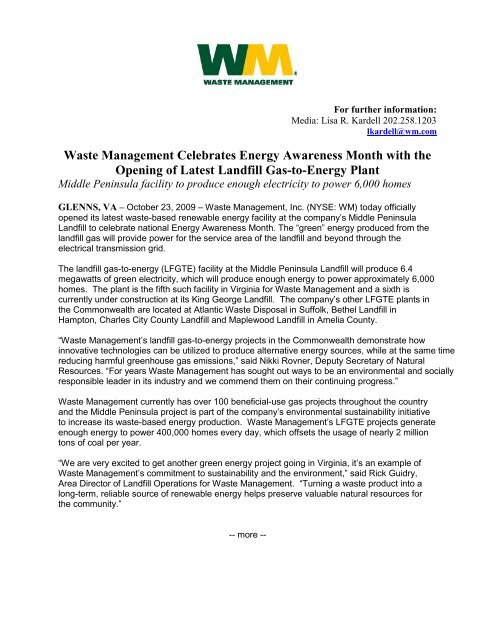WM Middle Peninsula facility to Produce Enough Electricity to Power ...
WM Middle Peninsula facility to Produce Enough Electricity to Power ...
WM Middle Peninsula facility to Produce Enough Electricity to Power ...
You also want an ePaper? Increase the reach of your titles
YUMPU automatically turns print PDFs into web optimized ePapers that Google loves.
For further information:Media: Lisa R. Kardell 202.258.1203lkardell@wm.comWaste Management Celebrates Energy Awareness Month with theOpening of Latest Landfill Gas-<strong>to</strong>-Energy Plant<strong>Middle</strong> <strong>Peninsula</strong> <strong>facility</strong> <strong>to</strong> produce enough electricity <strong>to</strong> power 6,000 homesGLENNS, VA – Oc<strong>to</strong>ber 23, 2009 – Waste Management, Inc. (NYSE: <strong>WM</strong>) <strong>to</strong>day officiallyopened its latest waste-based renewable energy <strong>facility</strong> at the company’s <strong>Middle</strong> <strong>Peninsula</strong>Landfill <strong>to</strong> celebrate national Energy Awareness Month. The “green” energy produced from thelandfill gas will provide power for the service area of the landfill and beyond through theelectrical transmission grid.The landfill gas-<strong>to</strong>-energy (LFGTE) <strong>facility</strong> at the <strong>Middle</strong> <strong>Peninsula</strong> Landfill will produce 6.4megawatts of green electricity, which will produce enough energy <strong>to</strong> power approximately 6,000homes. The plant is the fifth such <strong>facility</strong> in Virginia for Waste Management and a sixth iscurrently under construction at its King George Landfill. The company’s other LFGTE plants inthe Commonwealth are located at Atlantic Waste Disposal in Suffolk, Bethel Landfill inHamp<strong>to</strong>n, Charles City County Landfill and Maplewood Landfill in Amelia County.“Waste Management’s landfill gas-<strong>to</strong>-energy projects in the Commonwealth demonstrate howinnovative technologies can be utilized <strong>to</strong> produce alternative energy sources, while at the same timereducing harmful greenhouse gas emissions,” said Nikki Rovner, Deputy Secretary of NaturalResources. “For years Waste Management has sought out ways <strong>to</strong> be an environmental and sociallyresponsible leader in its industry and we commend them on their continuing progress.”Waste Management currently has over 100 beneficial-use gas projects throughout the countryand the <strong>Middle</strong> <strong>Peninsula</strong> project is part of the company’s environmental sustainability initiative<strong>to</strong> increase its waste-based energy production. Waste Management’s LFGTE projects generateenough energy <strong>to</strong> power 400,000 homes every day, which offsets the usage of nearly 2 million<strong>to</strong>ns of coal per year.“We are very excited <strong>to</strong> get another green energy project going in Virginia, it’s an example ofWaste Management’s commitment <strong>to</strong> sustainability and the environment,” said Rick Guidry,Area Direc<strong>to</strong>r of Landfill Operations for Waste Management. “Turning a waste product in<strong>to</strong> along-term, reliable source of renewable energy helps preserve valuable natural resources forthe community.”-- more --
The plant captures the landfill gas, primarily methane, through a network of pipes and wellsdrilled in<strong>to</strong> the landfill. A vacuum system draws the gas from the landfill and conveys it <strong>to</strong> thepower plant where it fuels the engines driving the genera<strong>to</strong>rs <strong>to</strong> produce electricity. The landfillgas recovery system includes more than 40 vertical gas extraction wells. Prior <strong>to</strong> the LFGTEplant being built, the landfill gas was safely burned at a central flare.The landfill will produce gas for the power plant for the next several decades and continue evenafter the landfill no longer accepts waste.A pioneer in LFGTE projects, Waste Management designed and operated its first <strong>facility</strong> in theUnited States more than 20 years ago. With 273 landfills, Waste Management is the country’slargest landfill opera<strong>to</strong>r and is in a unique position <strong>to</strong> expand waste-based renewable powergeneration across the country. The company is also exploring partnerships <strong>to</strong> expand its landfillgas-<strong>to</strong>-energy technology <strong>to</strong> other private and municipal landfills.In Oc<strong>to</strong>ber 2007, Waste Management announced its new sustainability initiative <strong>to</strong> double itscontribution <strong>to</strong> the country’s renewable energy portfolio by 2020 through waste-based energy projects.Today, Waste Management creates enough energy <strong>to</strong> power 1 million homes each year. By 2020 itaims <strong>to</strong> double that output <strong>to</strong> produce enough power for more than 2 million homes.About Waste ManagementWaste Management, based in Hous<strong>to</strong>n, Texas, is the leading provider of comprehensive wastemanagement services in North America. Our subsidiaries provide collection, transfer, recyclingand resource recovery, and disposal services. We are also a leading developer, opera<strong>to</strong>r andowner of waste-<strong>to</strong>-energy and landfill gas-<strong>to</strong>-energy facilities in the United States. Ourcus<strong>to</strong>mers include residential, commercial, industrial, and municipal cus<strong>to</strong>mers throughout NorthAmerica. More information about Waste Management can be found at www.wm.com orwww.thinkgreen.com.###
















